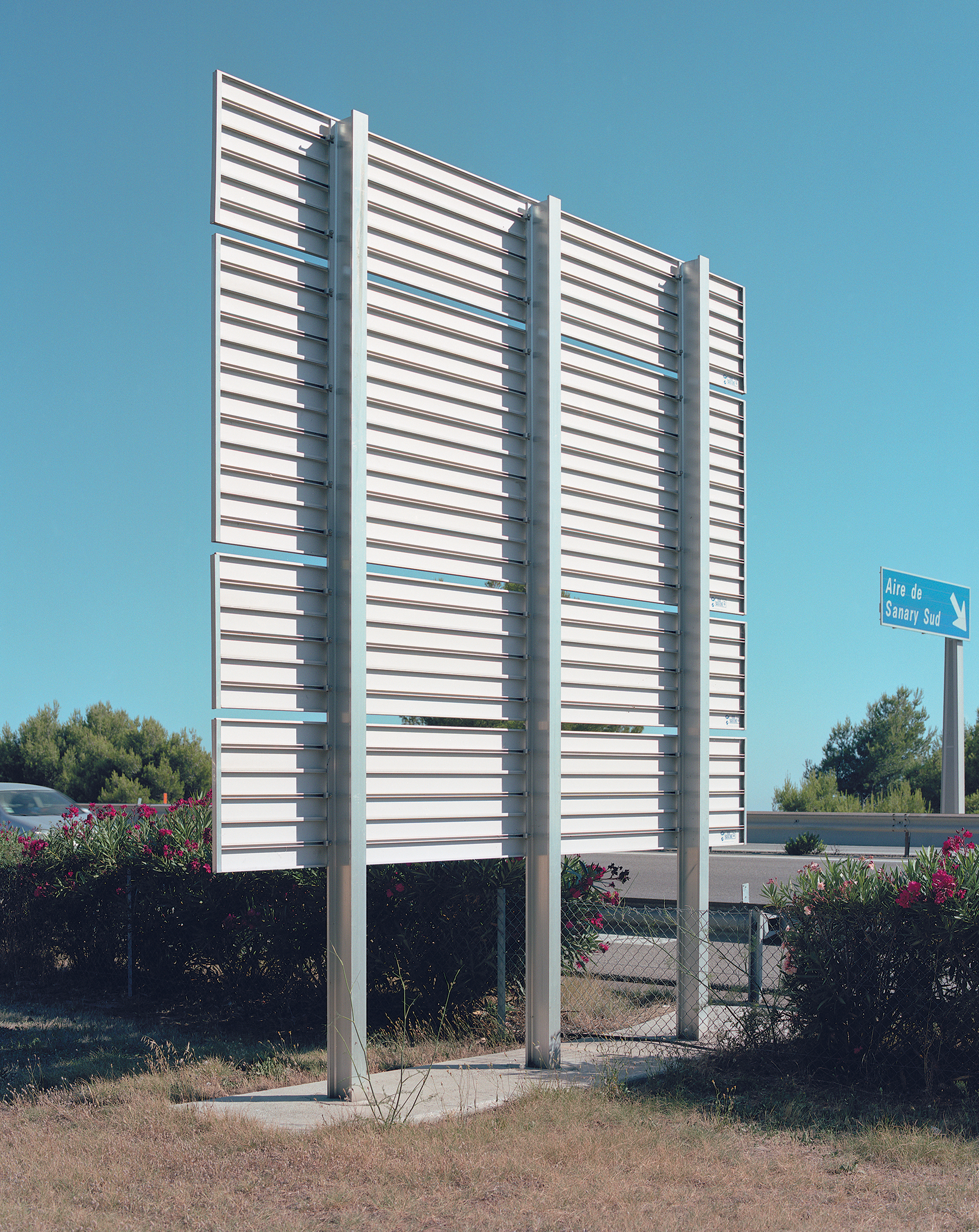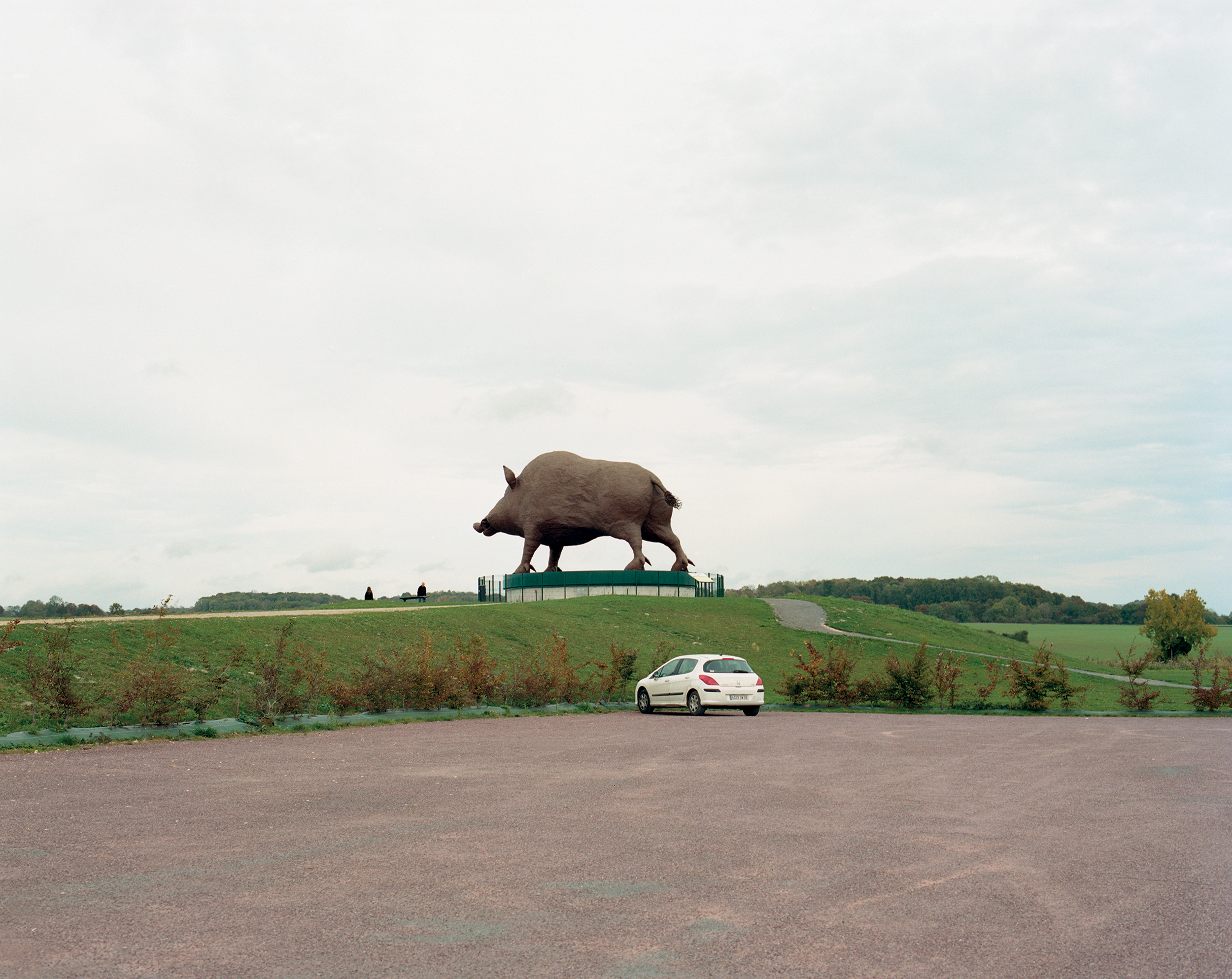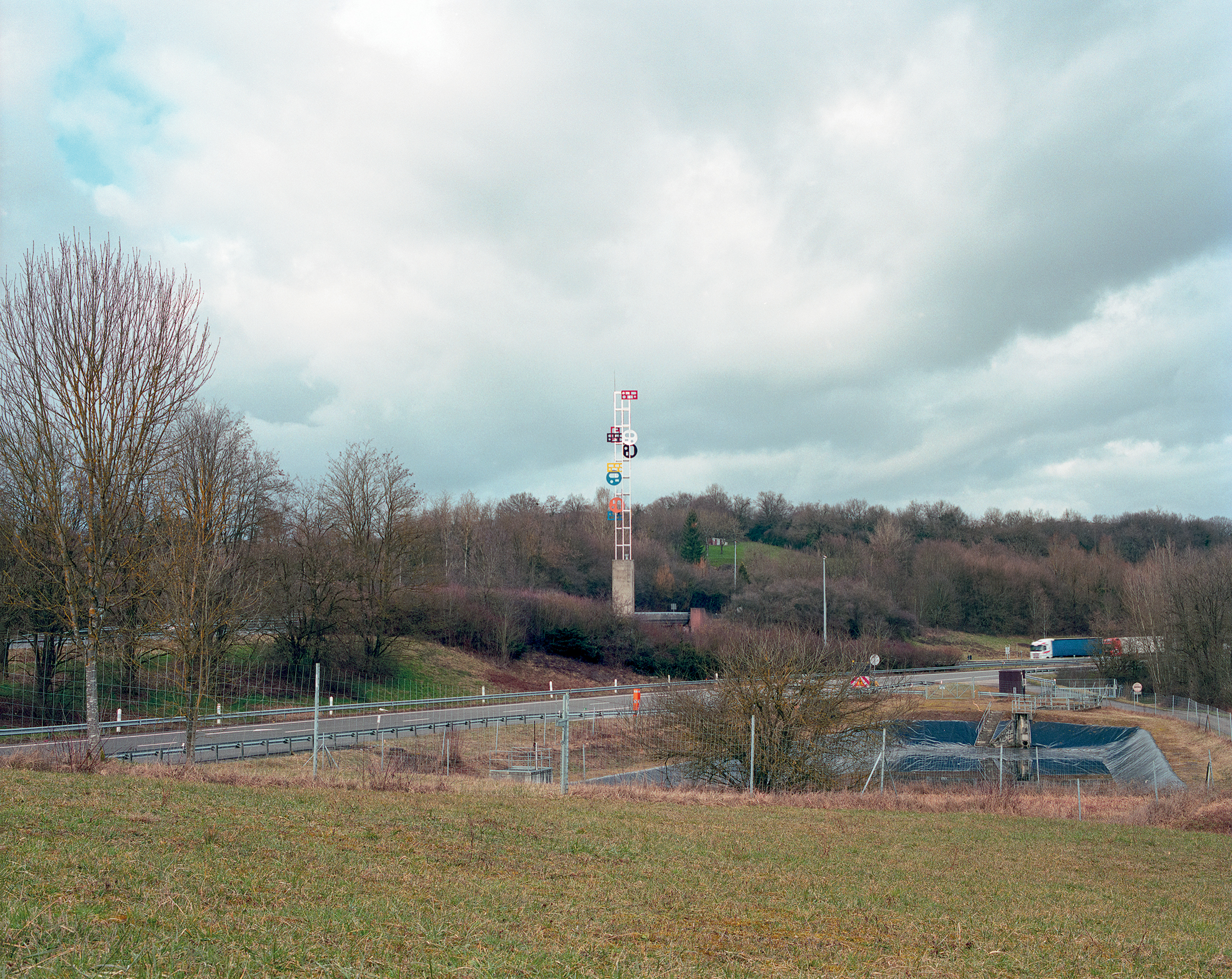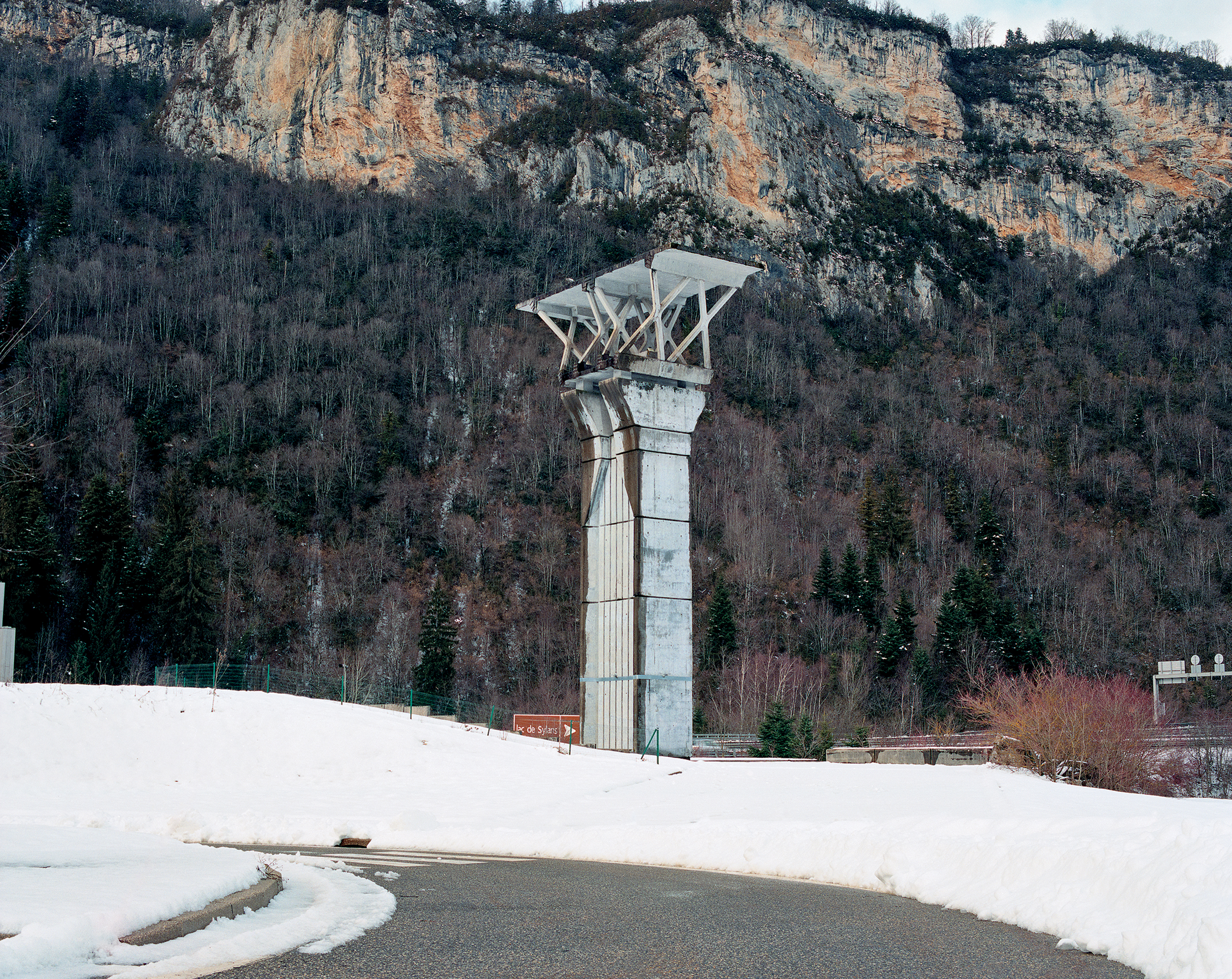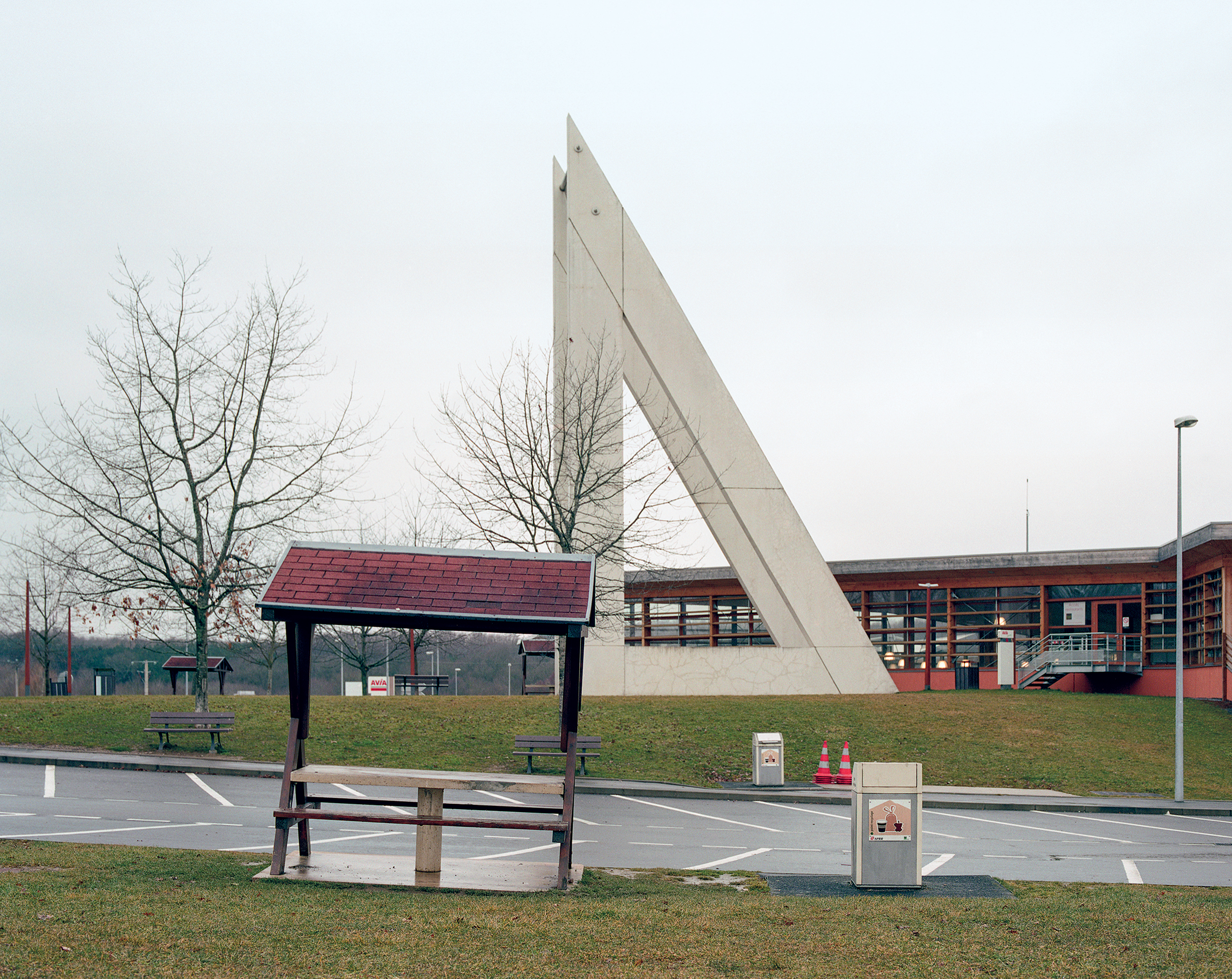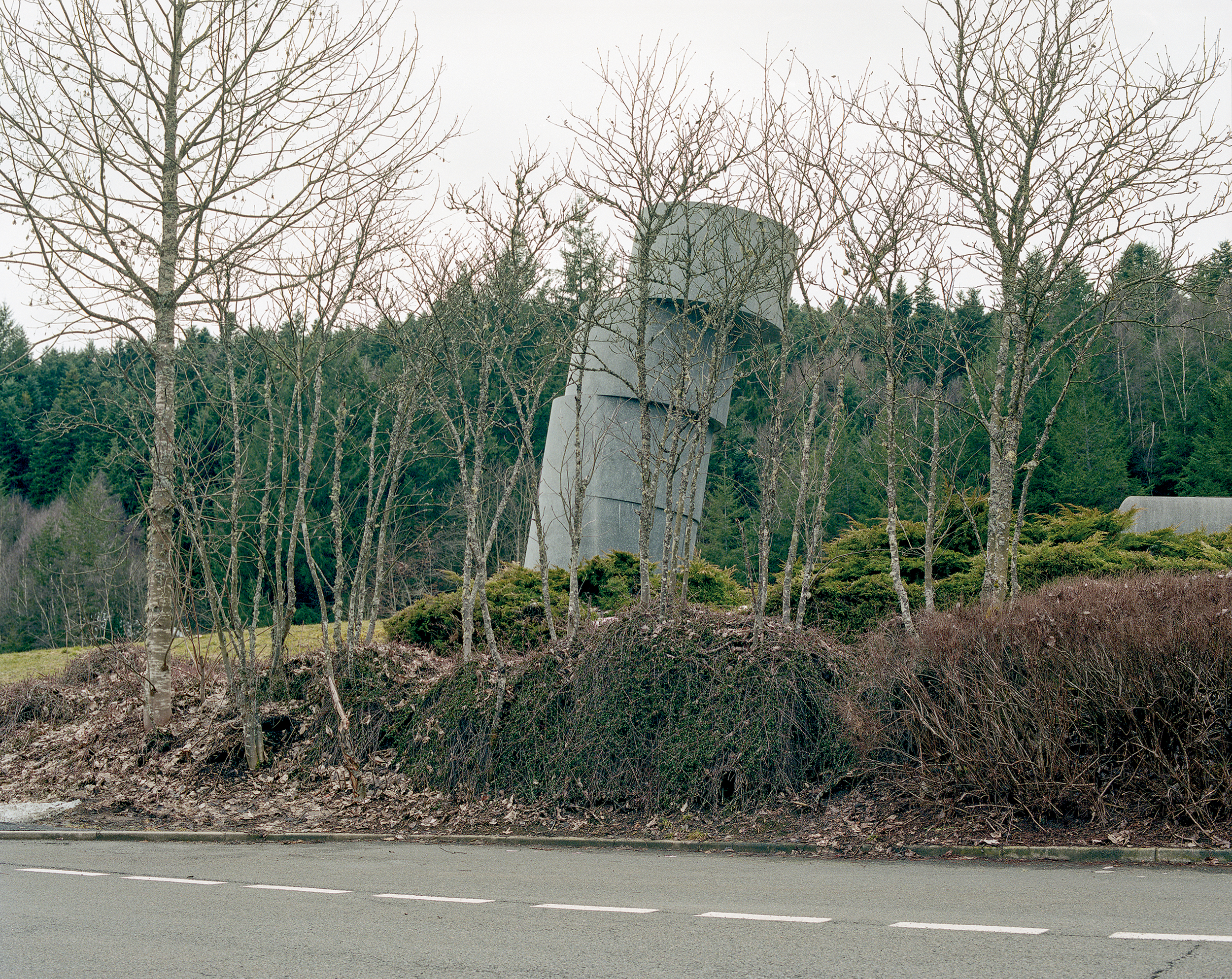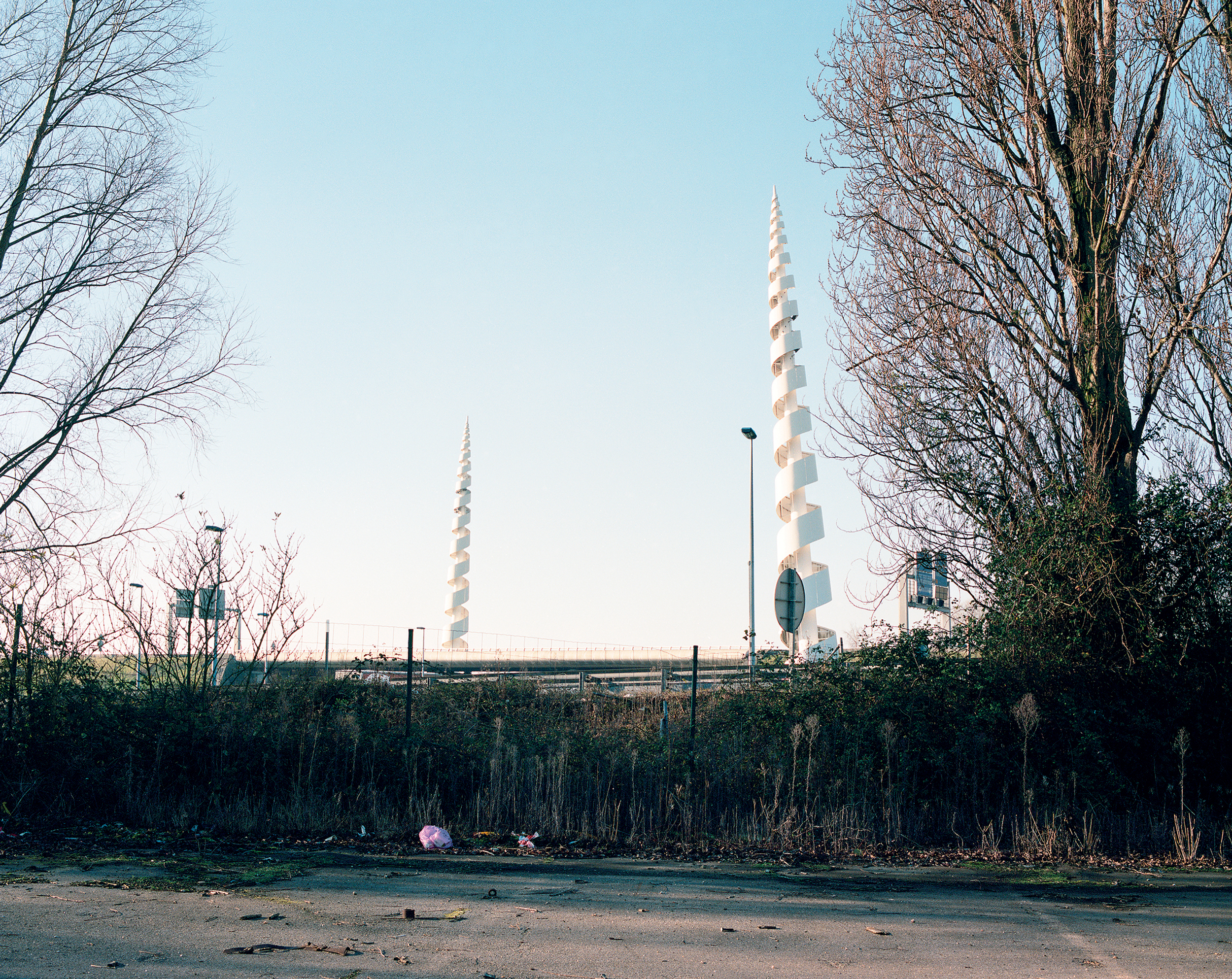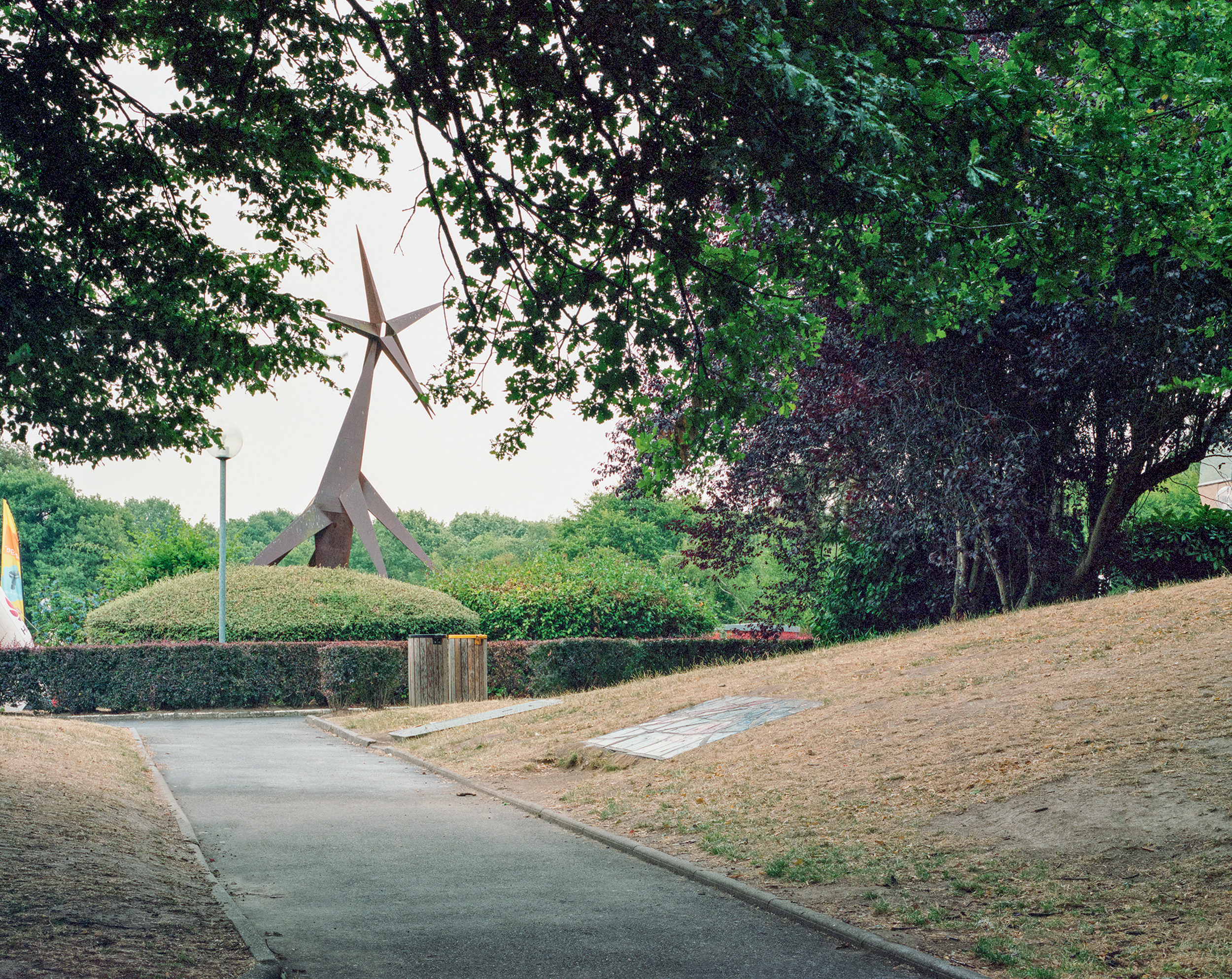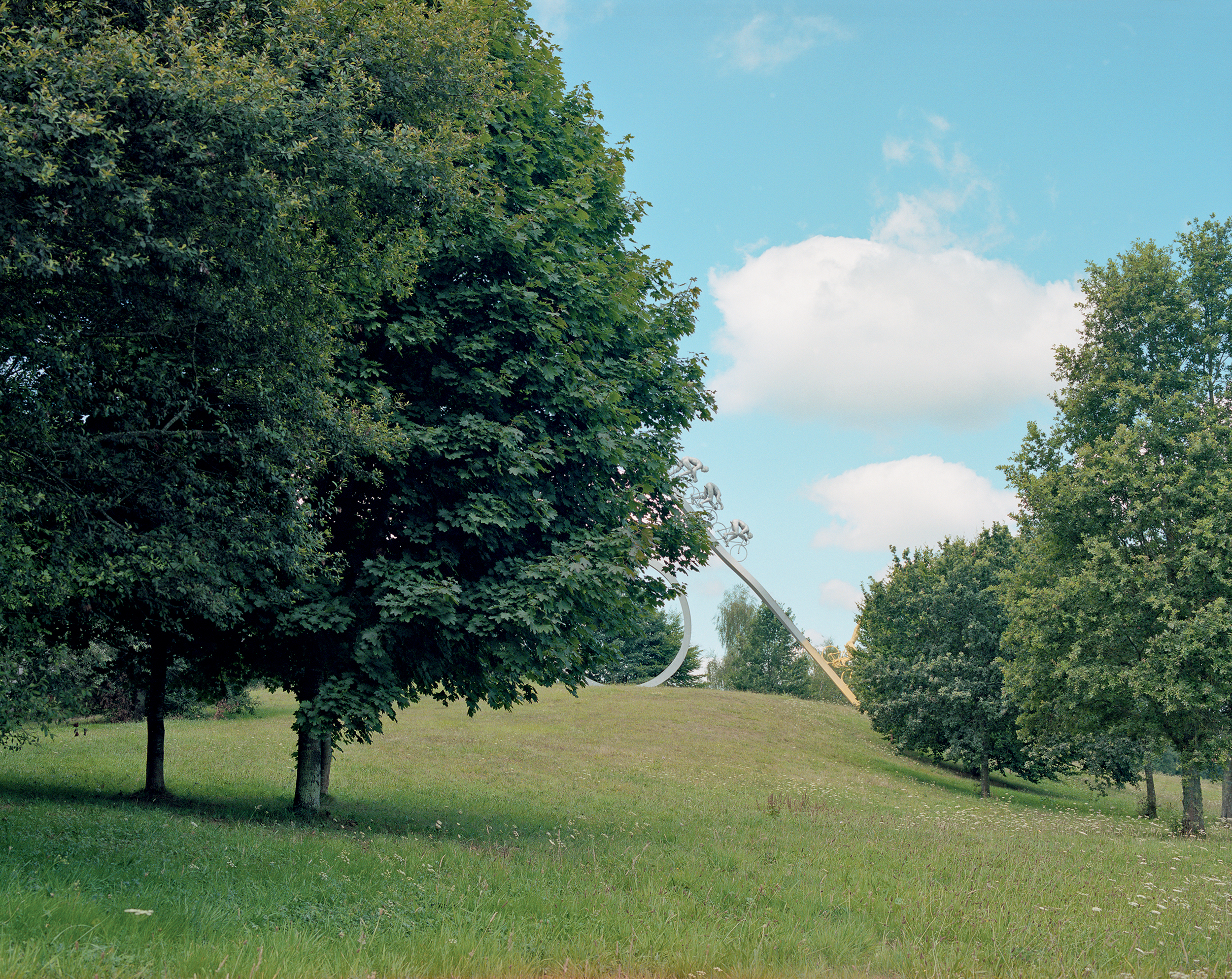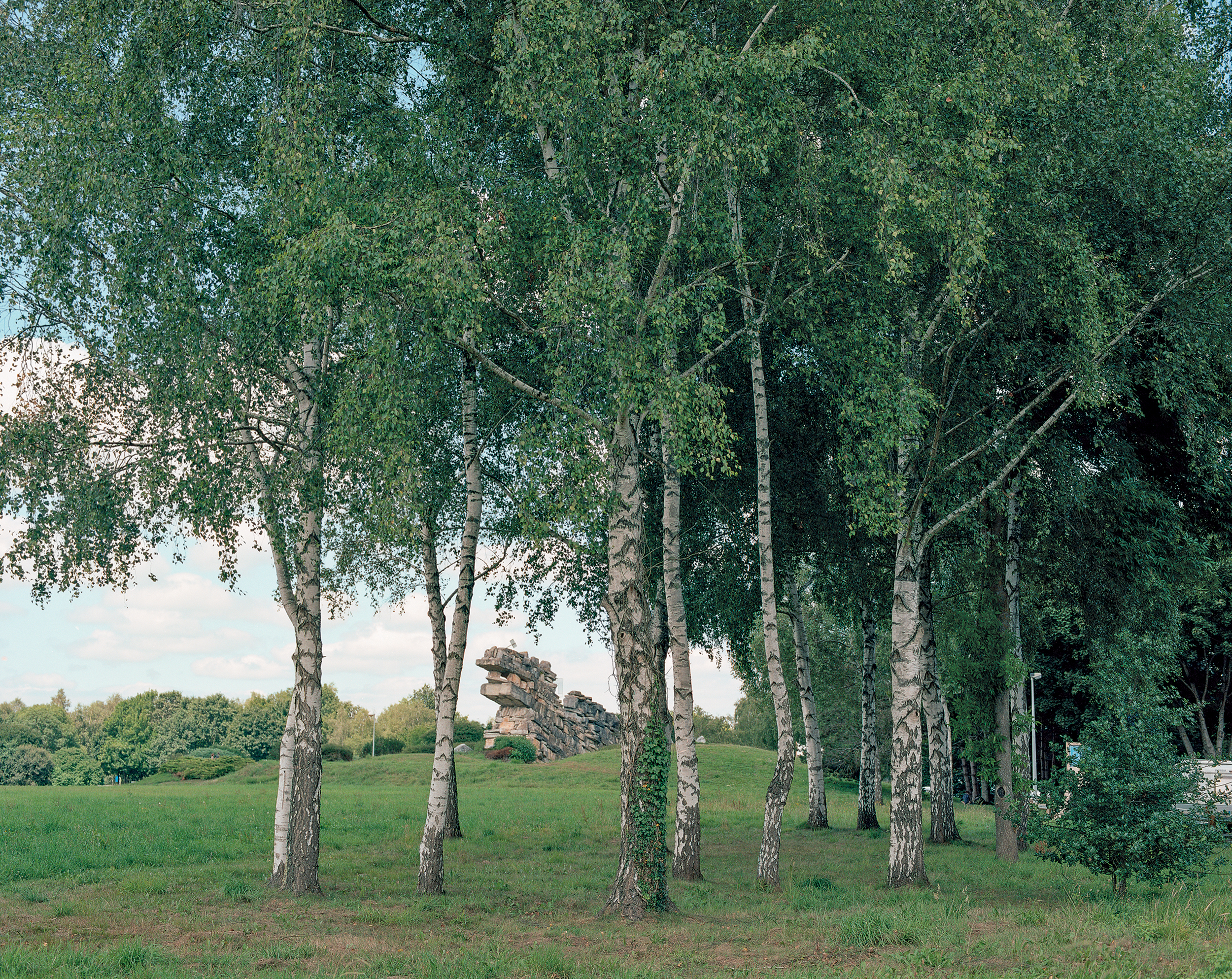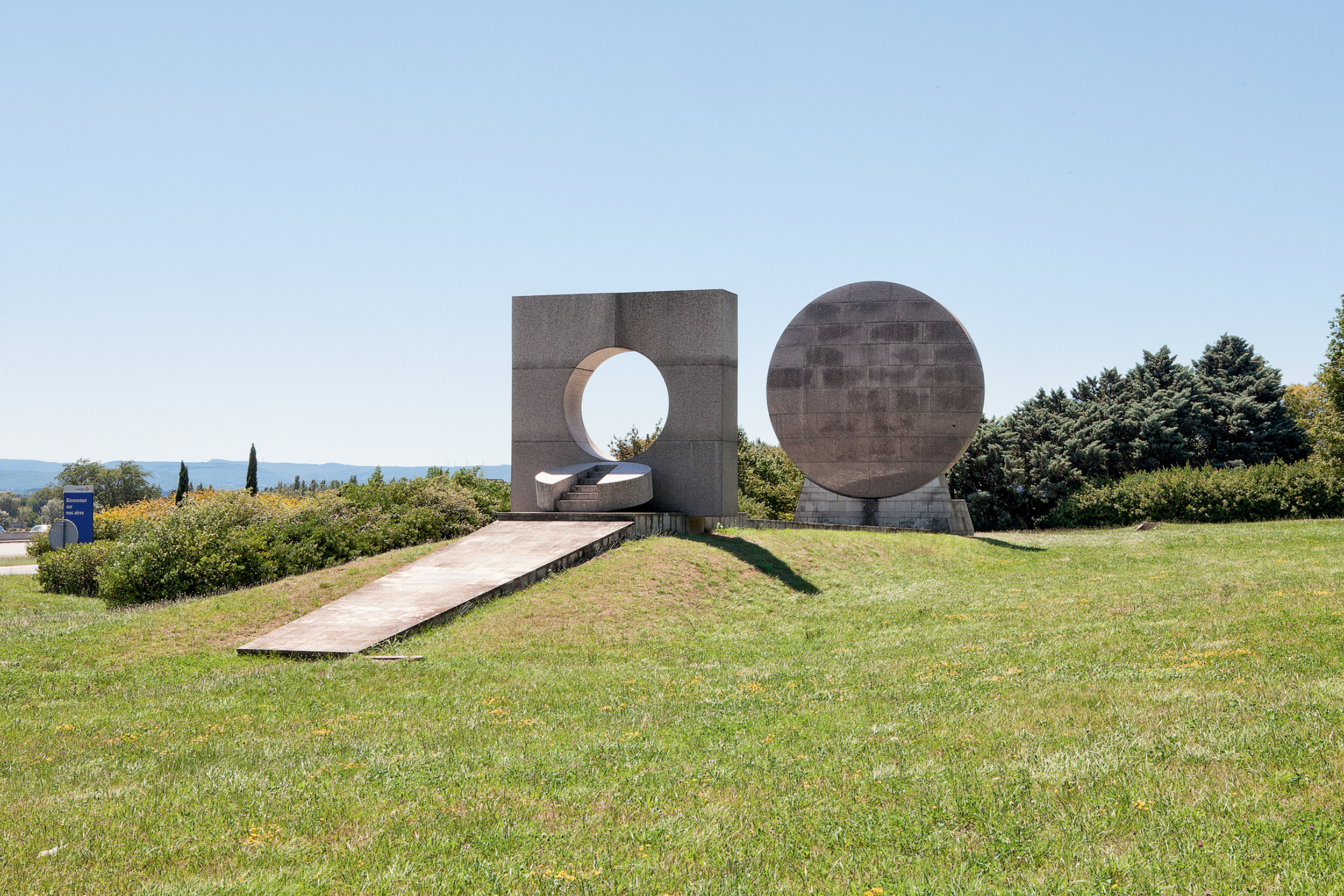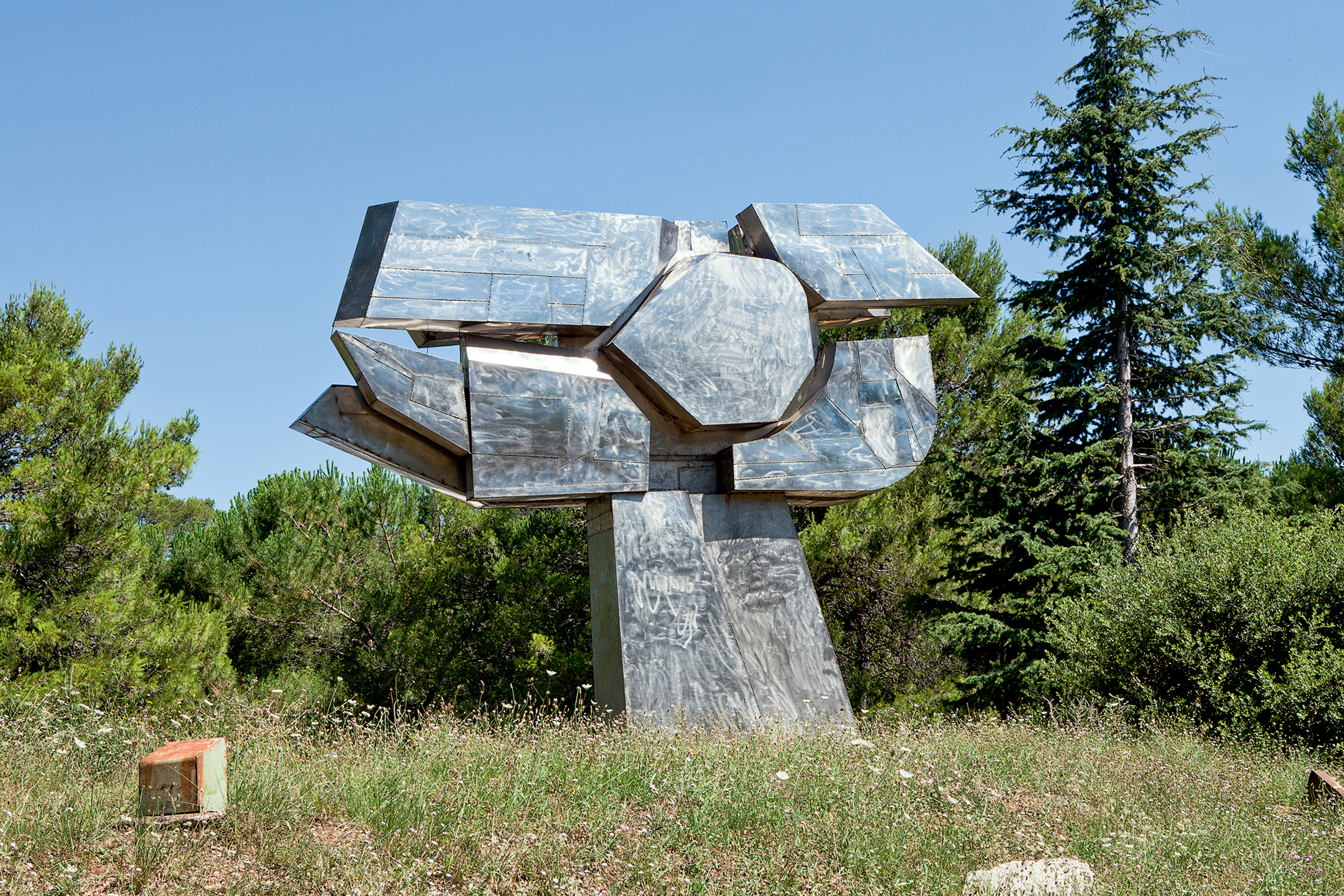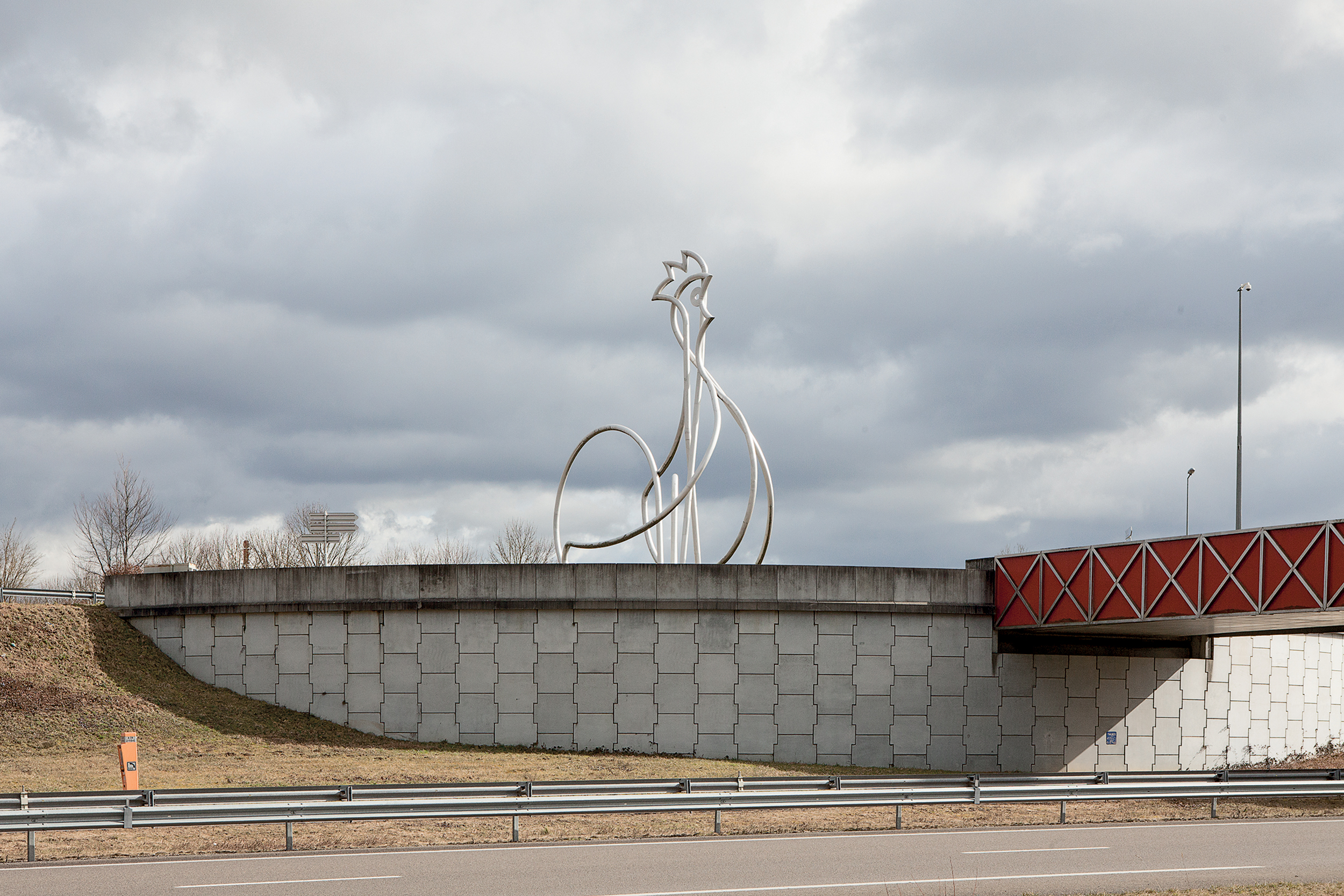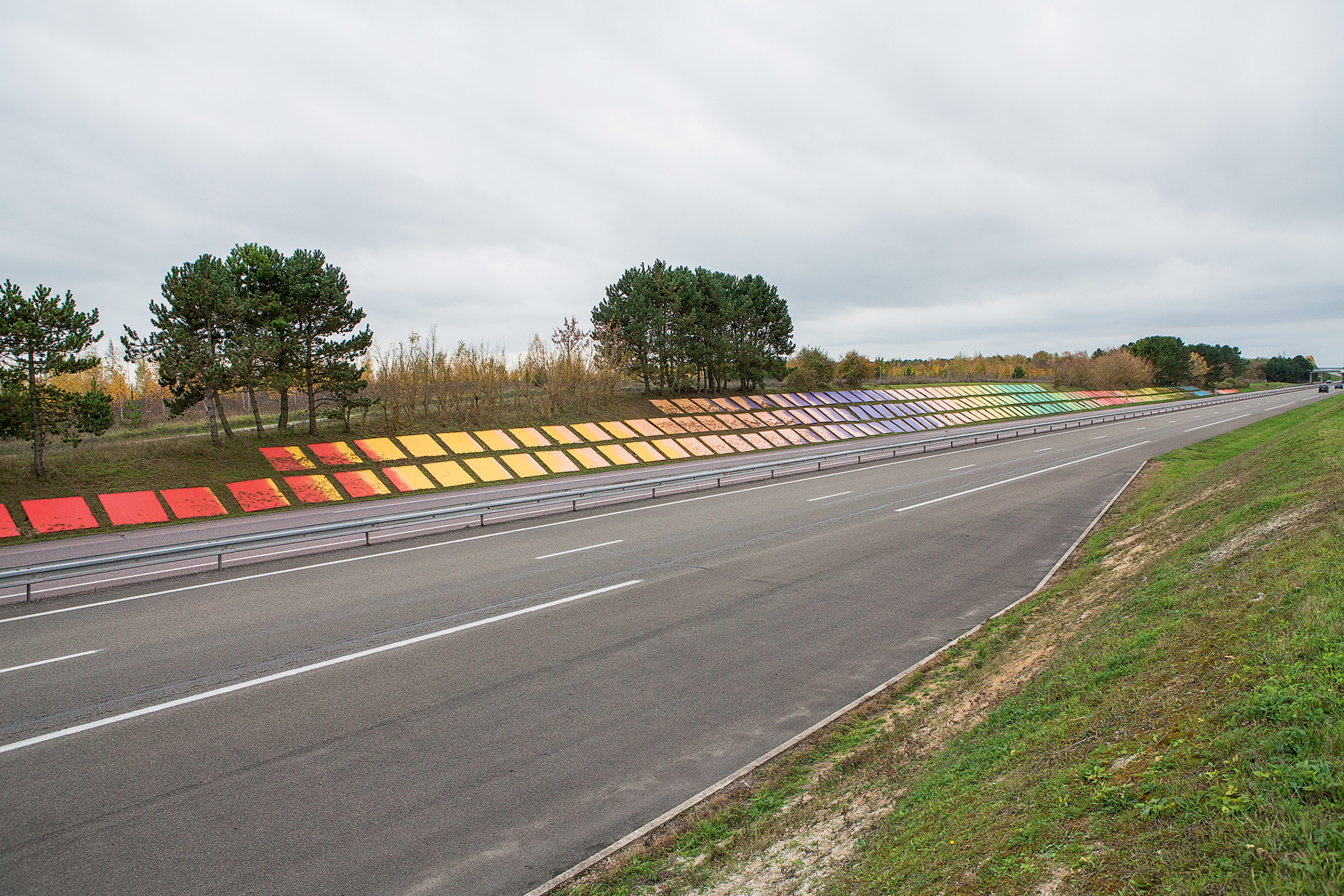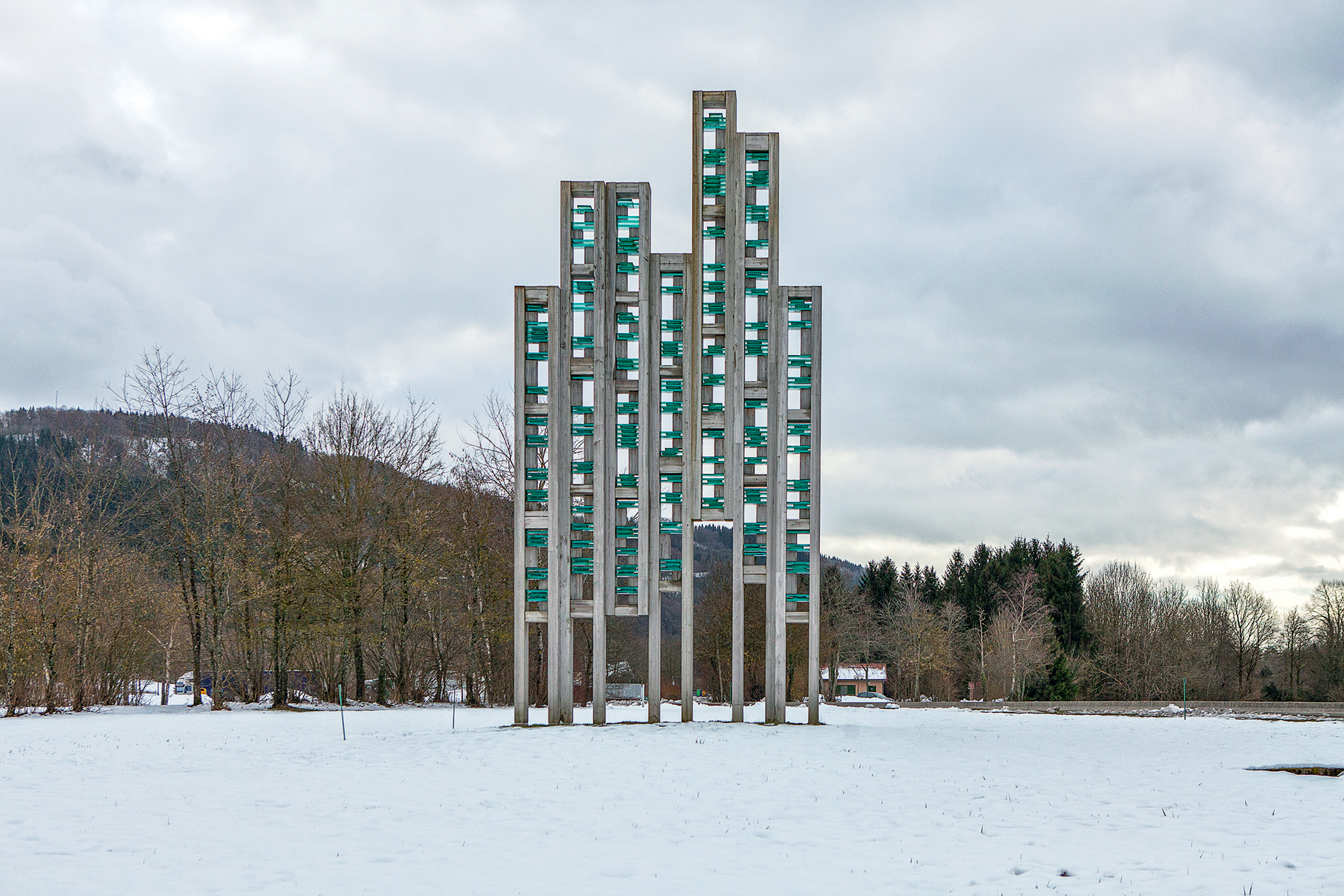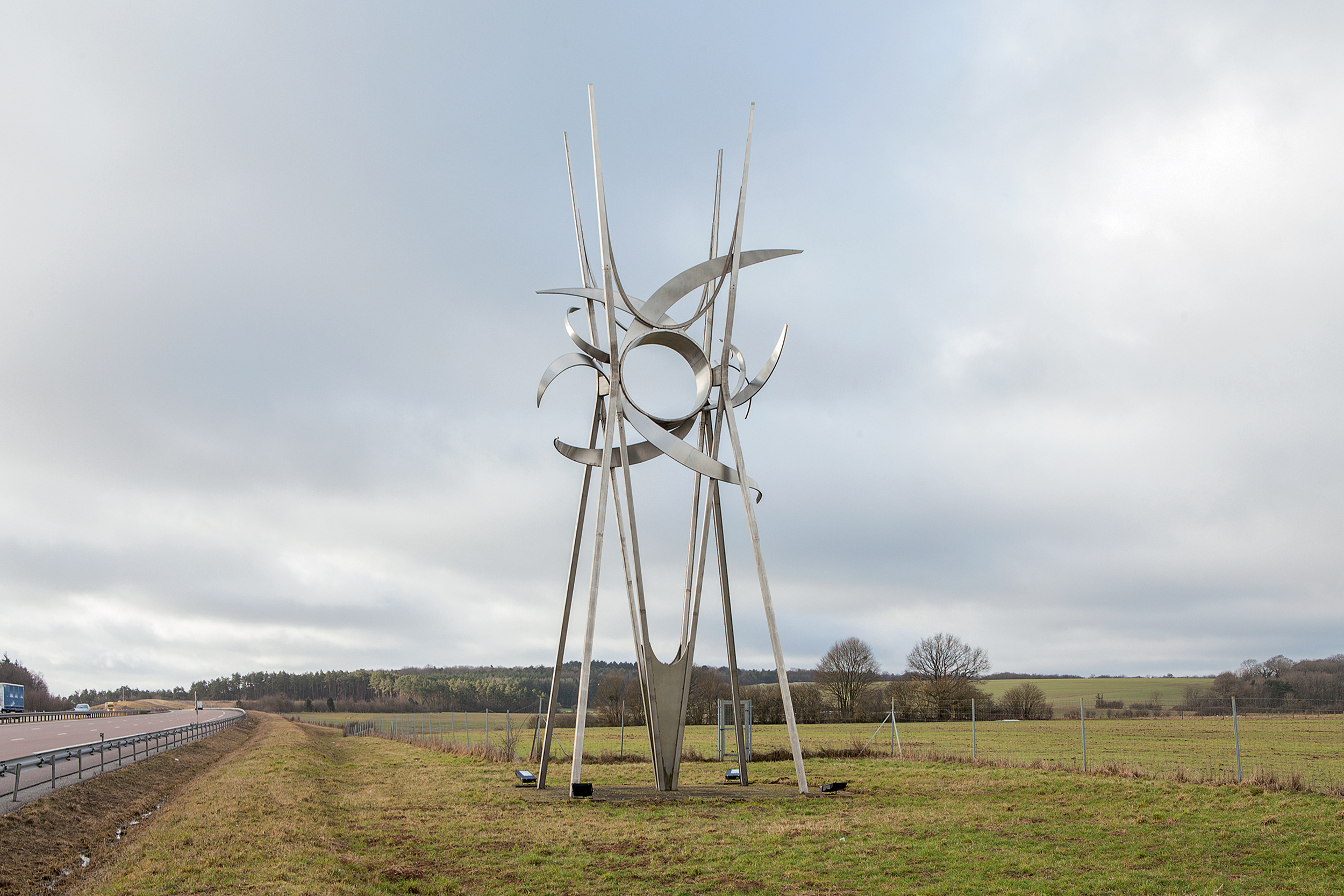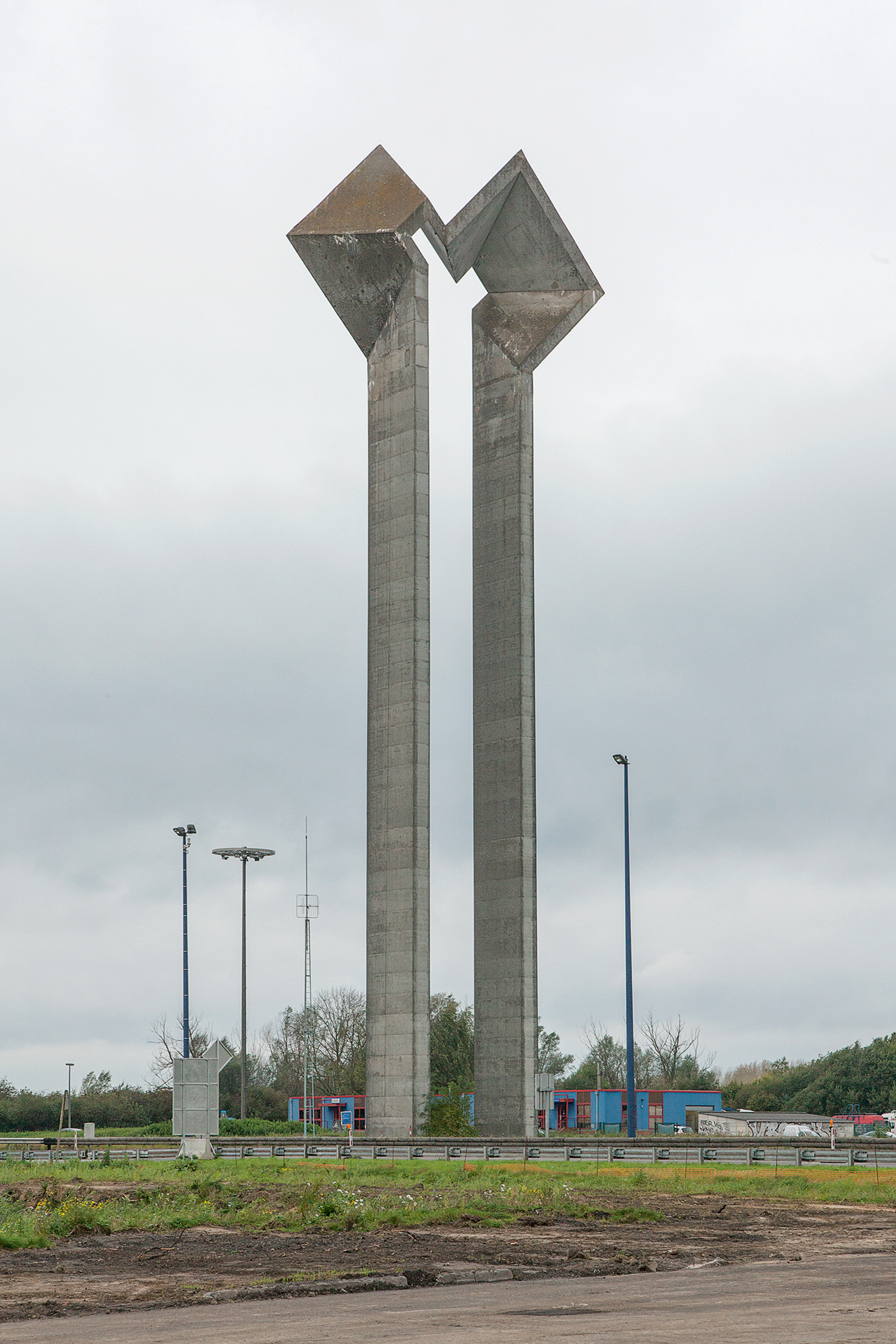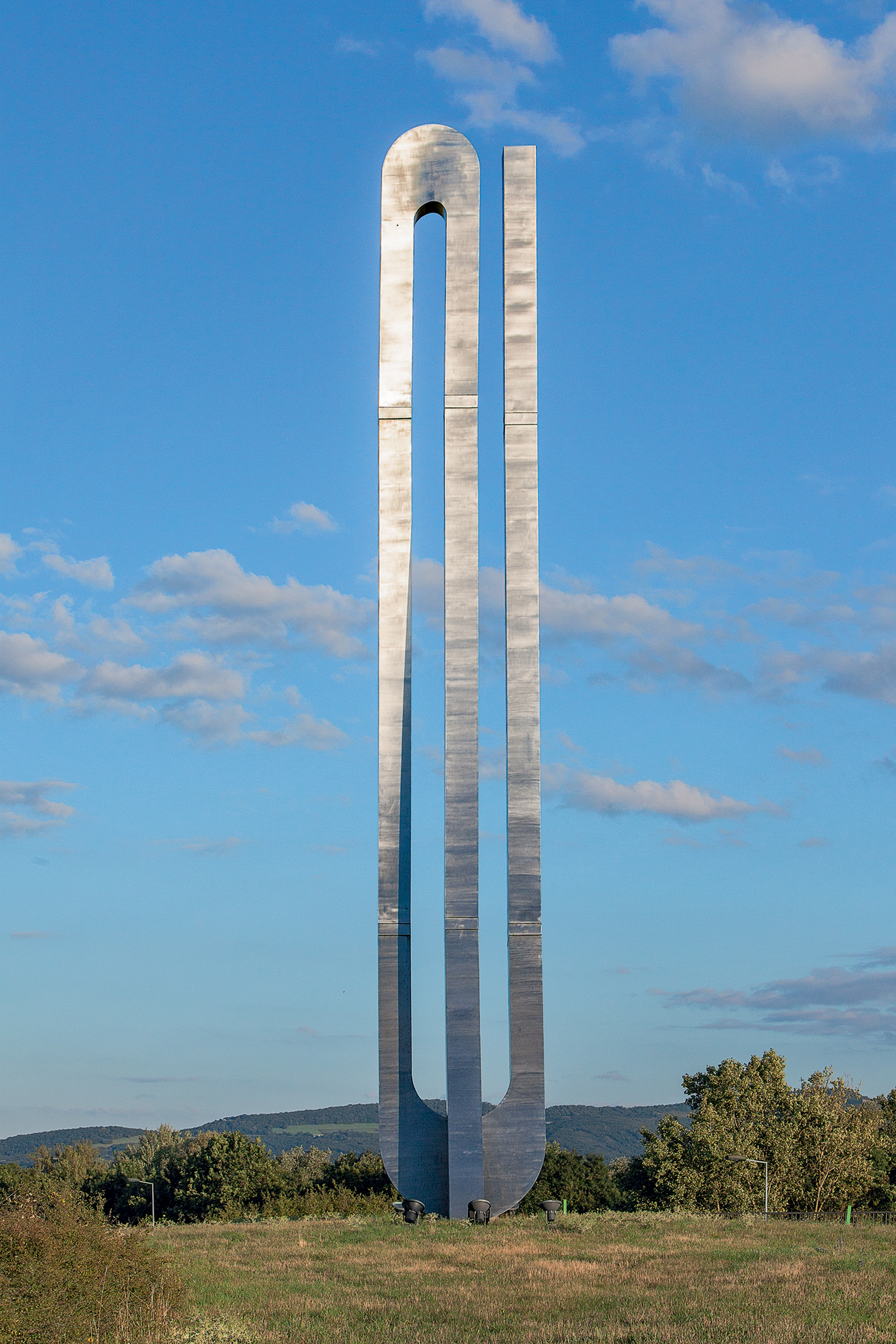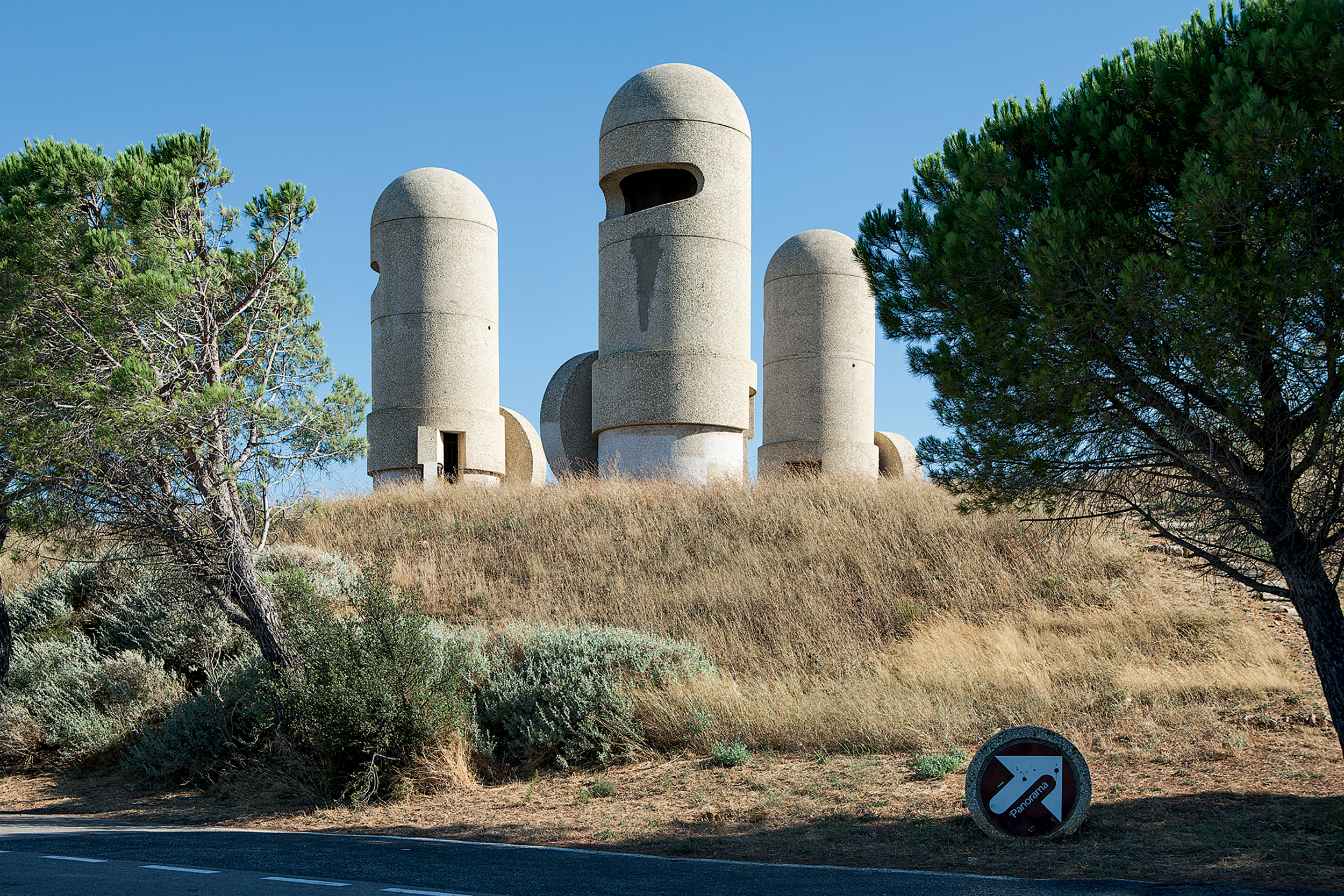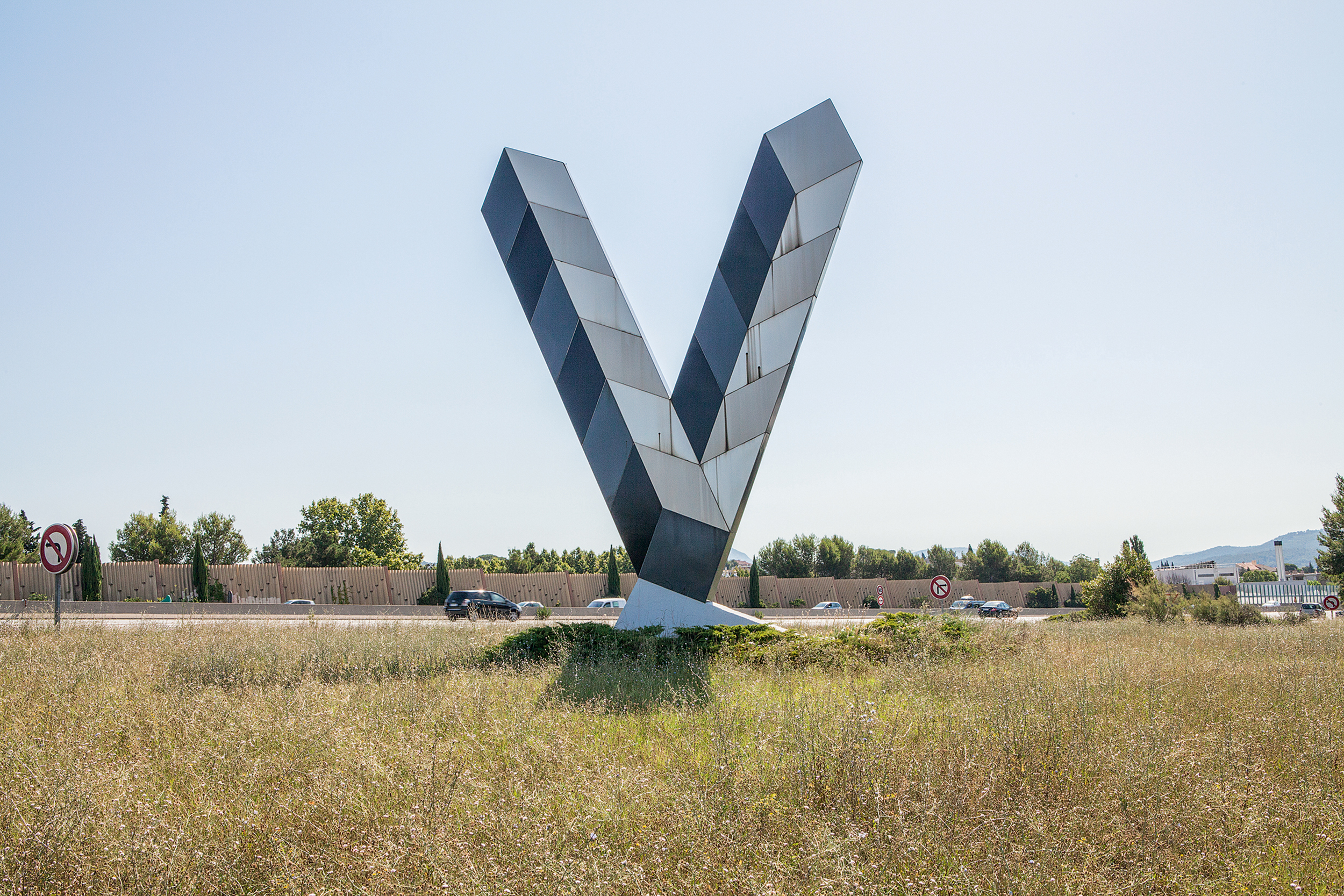Julien Lelièvre
Art d’autoroute
2010–2015
Julien Lelièvre put in thousands of kilometres and years of research to document and photograph seventy-one works of art dotted about on the French motorway network. This pictorial inventory, organised into twelve itineraries, is introduced by a corpus of photographs that act as a sensitive diary of his travels. Taken as a whole, the photos offer an unexpected insight into the peculiar world of the motorway and, for the first time, provide a broad perspective on this sometimes disparaged and often unrecognised art form.
—
There is no boredom quite so excruciating as that of driving on French motorways. At least that’s how it feels to me whenever I drive on them. And although motorways may produce visions of near blissfulness, especially at dusk, my state of mind whenever I embark on a motorway journey is one close to resignation. There is no denying that the absolute antithesis of roads, which play such an important part in my work, is the motorway and I try to avoid it. Nevertheless, my aversion is of no consequence and I am perfectly capable of ignoring it and of finding Julien Lelièvre’s endeavour both admirable, considering the time and energy he devoted to seeing it through, and courageous, when you consider the scant interest, if not contempt, people have for public commissions in general and motorway art in particular. In that respect, the author of this book is one of those unsung heroes who, in the face of total indifference, plough a lonely furrow, seeing through projects that no one would expect anyone to undertake. You need to be moved by something stronger than self-denial to pick up this kind of challenge and probably slightly mad, too, to imagine that you can rehabilitate such a discredited art form. Of course, in heaping praise on Julien Lelièvre like this, I’m sending a little bit of praise in my own direction, too, since in some respects, the obsessive nature of my work and my fondness for unfashionable objects, is not dissimilar to Julien Lelièvre’s.
Extact of Éric Tabuchi, «The Great French Museum», in Julien Lelièvre, Art d’autoroute, Paris, Building Books, 2019, pp. 21-22.
—
Is there such a thing as motorway art and, if so, what are its distinguishing qualities? Julien Lelièvre’s project lists 71 sculptures. An article in Le Monde in August 2018, suggested that there are 83 of them altogether, three-quarters of which were designed and erected in the 1980s and 1990s. As in any inventory (whether of roundabout statues, animal art, still-lifes, or murals), some are good and some are bad. The right question should be whether a motorway is a possible condition for the existence of art—after all, few people are not motorway users; it is virtually impossible to avoid using them if you travel by road. Can these roads become the site of an aesthetic experience? And if so, under what conditions? A s a road user, the first indication is the feeling of being a captive audience. It is impossible not to see them, impossible to look away. Most of the sculptures make their presence felt from way ahead; they loom into the field of vision of drivers who, for obvious reasons, cannot close their eyes. They stand tall and ostentatious. Georges Saulterre’s Les Flèches des cathédrales [The Cathedral Spires, 1989] was listed in the Guinness Book of Records as “the tallest sculpture made by a man.” Marta Pan’s impressive Signe infini [Infinite Sign] is 25 metres high. Woinic, a giant wild boar commissioned by the Conseil Général des Ardennes, at eight metres high and weighing in at fifty tons, is reputed to be the “biggest wild boar in the world.” But although art can be readily thought of as proposing something, it can less easily or systematically impose itself on the viewer. In fact, as Julien Lelièvre, who would like to remedy the situation, has remarked, the often massive works of art that stand on the verges of motorways and which flash past the eyes of millions of motorists, remain unappreciated or even unknown. Even when they are inordinately large, they can be insignificant; even when they are imposing, they can be invisible. Robert Musil made the same point about public monuments, namely that the most conspicuous structures erected in memory of great men or glorious deeds are, in fact, rendered inconspicuous and unappreciated, as if the fact of not seeing them were a source of freedom. “There is nothing in this world as invisible as a monument. They are no doubt erected to be seen—indeed to attract attention… Many people have this same experience even with larger-than-life statues.” The spectacular can prove to be so insignificant that, because it does not address anyone in particular, it is seen by no one. In other words, the public for motorway art, far from being captive, is in fact absent.
Extact of Joëlle Zask, «From movement to action», in Julien Lelièvre, Art d’autoroute, Paris, Building Books, 2019, pp. 101-104.
—
EL • What are your first memories of motorway art?
JL • Looking back as an adult, I remember going off on holiday with my parents on the motorway. It was in the 1990s. I was struck by those huge sculptures. There was also that work by Georges Saulterre, between Rouen and Paris, which I often used to see from the car when I was an art student.
EL • How did you get interested in the subject?
JL • I did my diploma project on the relationship between the general public and contemporary art. I did it on the city of Rouen. Five years ago, I was looking for a new project to get into at the same time as working as a graphic designer. I really liked the subject of motorway art, because everyone is familiar with at least one example of it, from the most cultured people to people who never set foot in a museum.
EL • It’s true. Those sculptures are a sort of national heritage.
JL • I am always delighted when someone says to me: “I remember that sculpture, it was an hour before arriving at our country house.” It’s quite rare for a work of art to be so connected to personal experience. It’s not what happens in museums. Motorway artworks are massive; you can’t miss them. They force themselves onto your attention.
EL • Is this project a way of celebrating them?
JL • Yes, especially when I realized that almost nothing had been done on them. When I first started my research, I was surprised to find that there was very little information, no catalogue listing the works, no notes or explanations for the general public. I’d heard about a thing called the Debron report—the beginnings of a list of these works. But even by going directly to the Ministry of Transport, the Ministry of Culture, and the various motorway operators, I never managed to lay my hands on it.
EL • So you were starting from scratch.
JL • I couldn’t find anything to build on and I almost gave up the project several times. But in the end, somebody from the Ministry sent me an embryonic list, and I managed to get an inventory from a WikiSara user (“the encyclopaedia of road and transport lovers”). By putting the two documents together, I began to get a list of all the works that existed. What I had to do then was narrow it down by removing any sculptures that had been moved or vandalised.
Extract of the interview with Julien Lelièvre by Émilie Laystary, in Julien Lelièvre, Art d’autoroute, Paris, Building Books, 2019, pp. 212-215.
